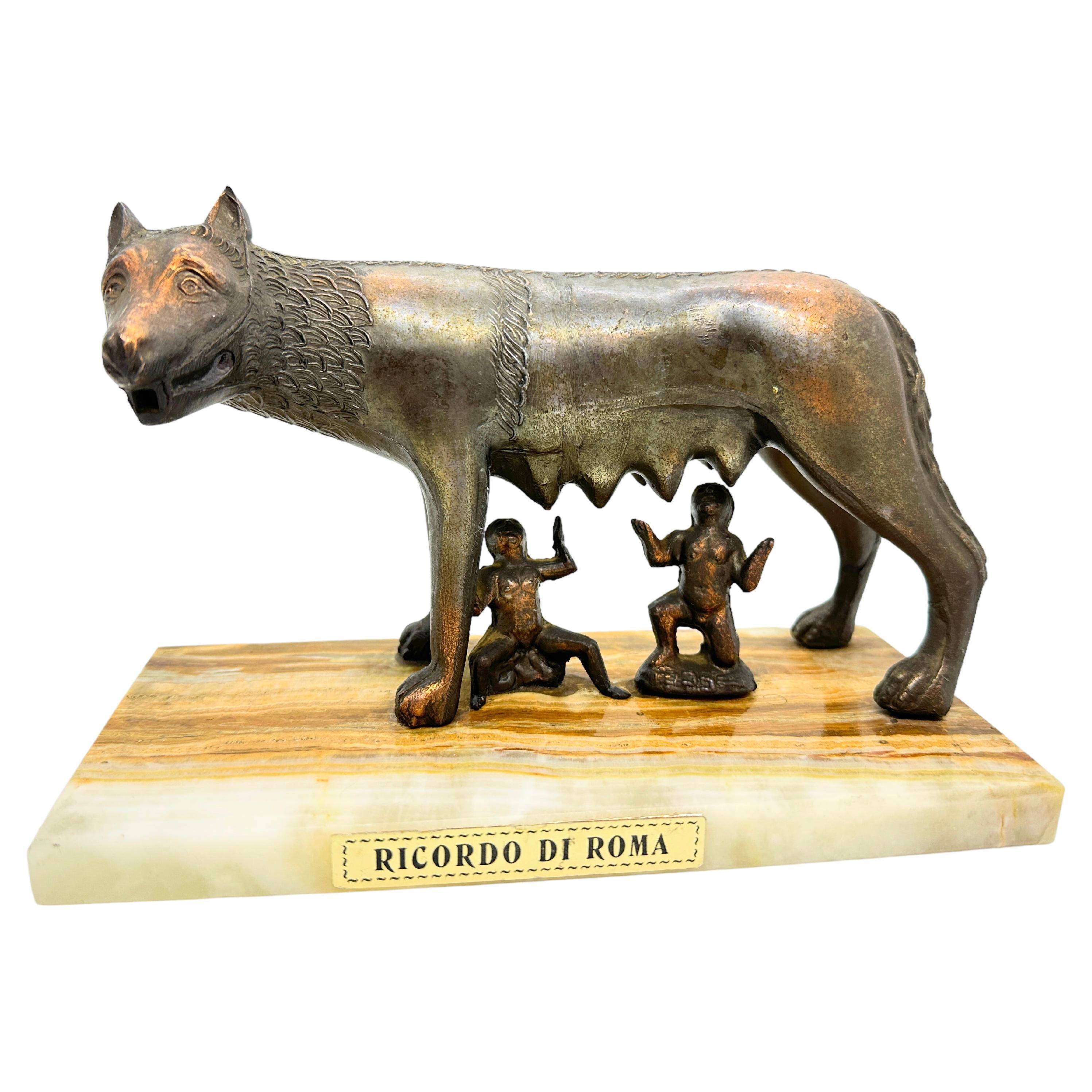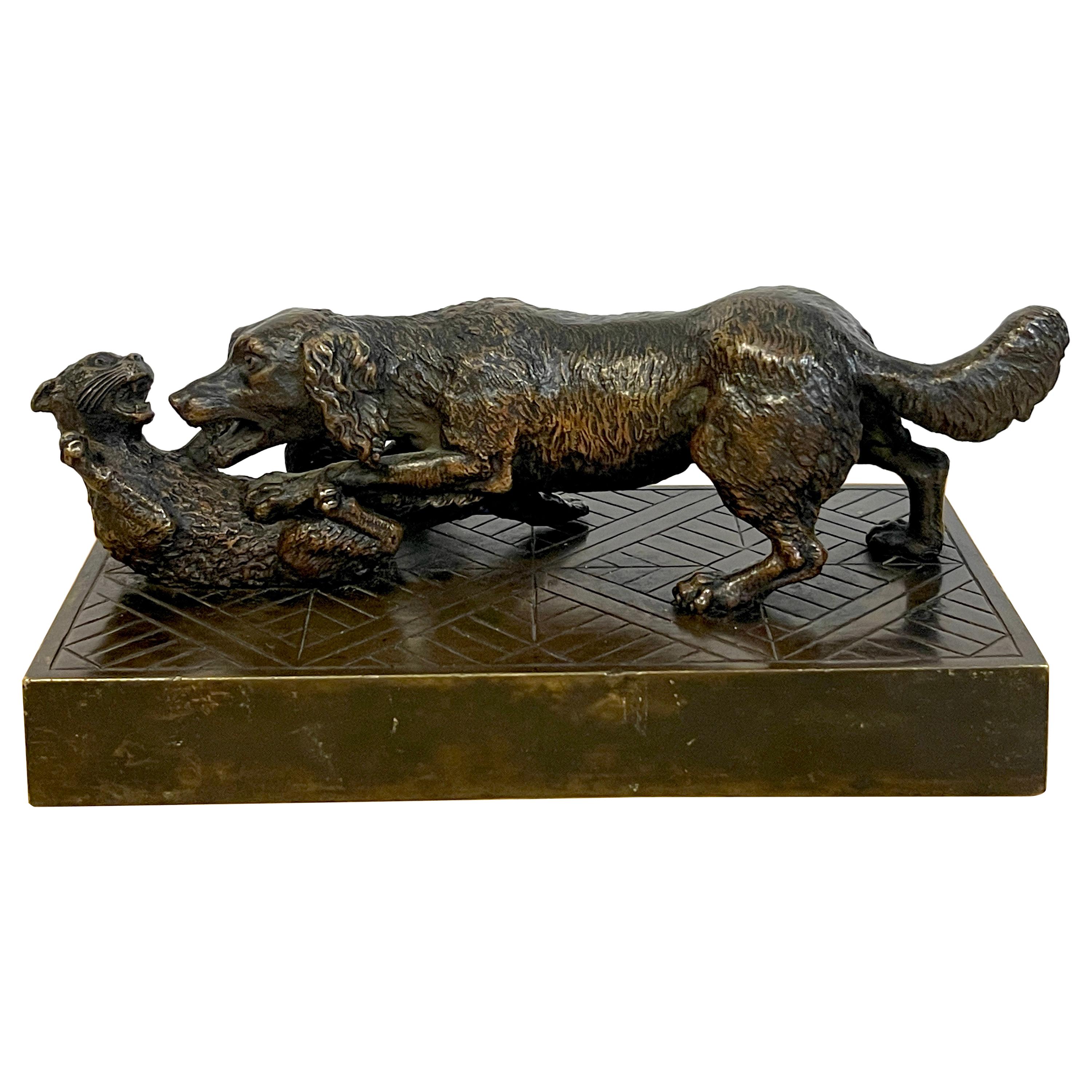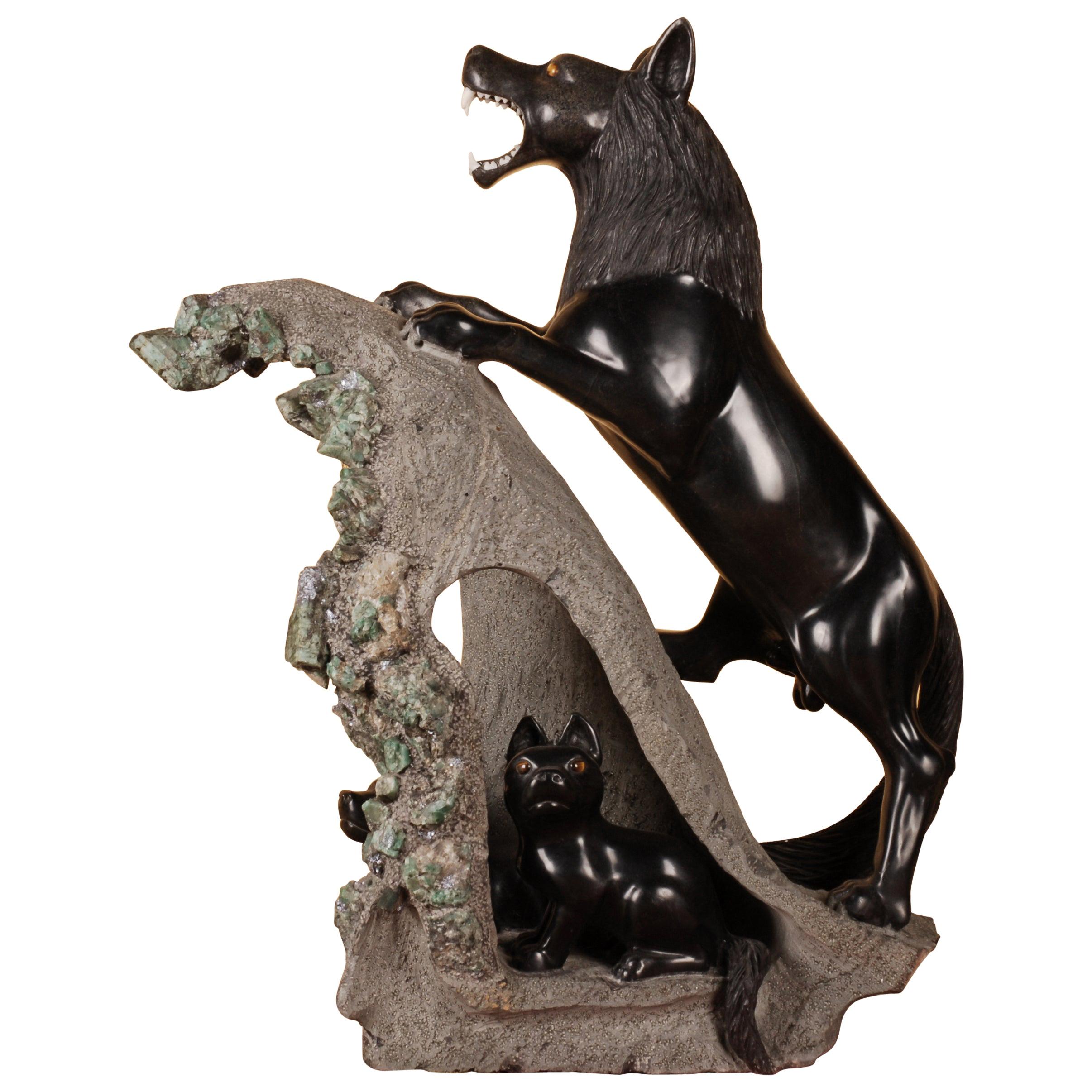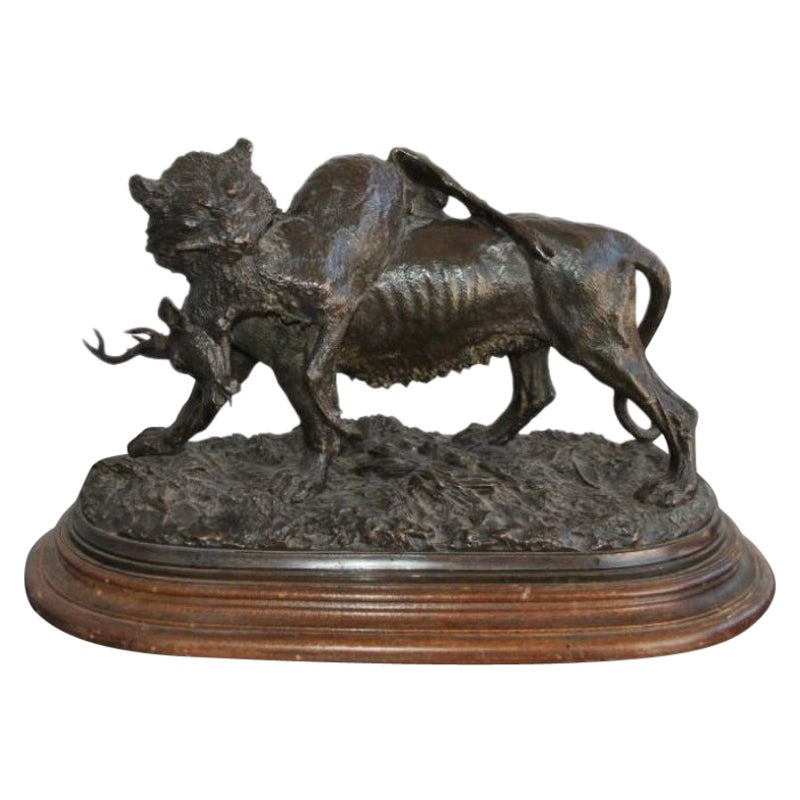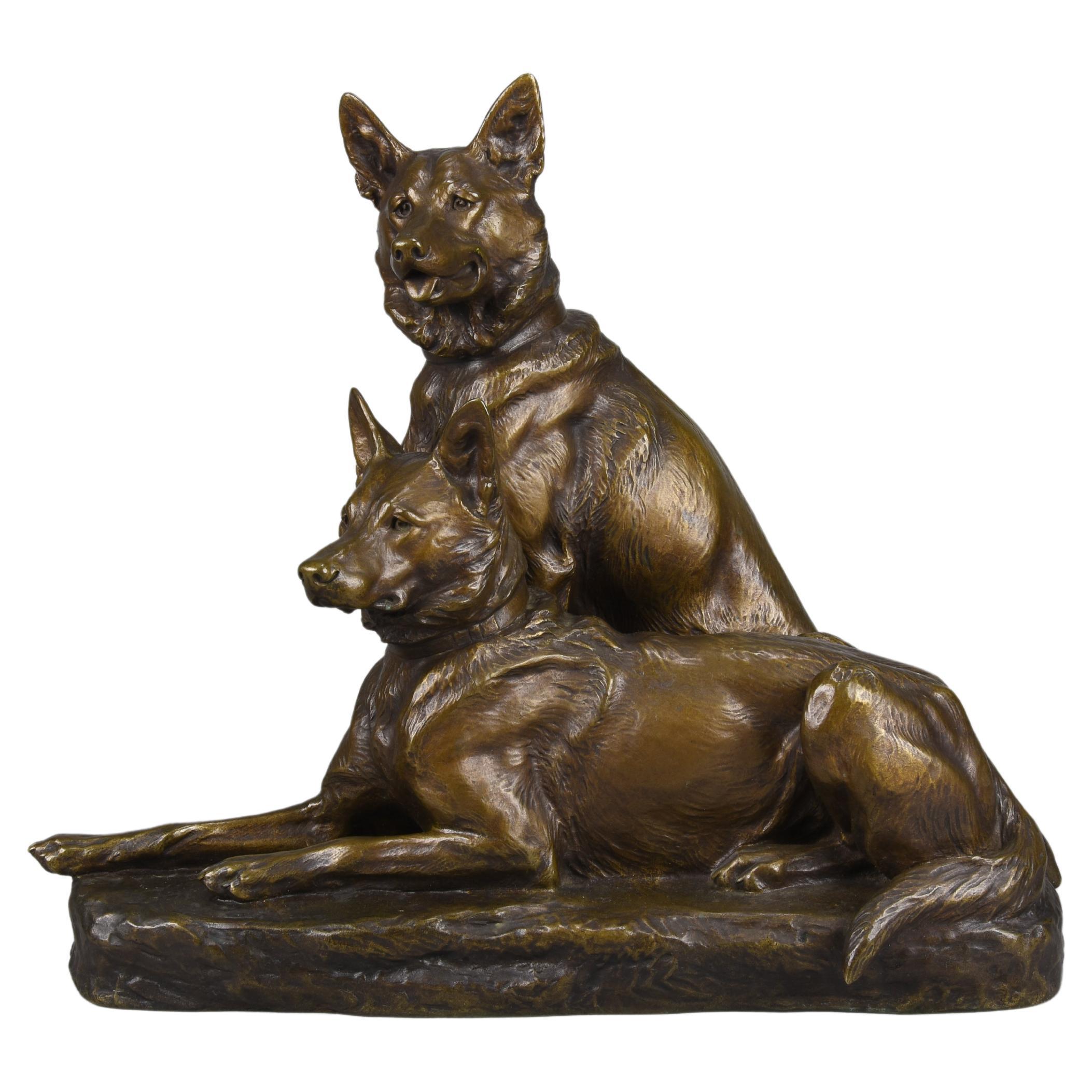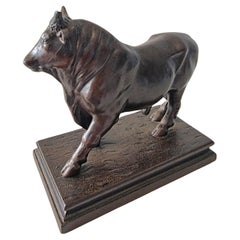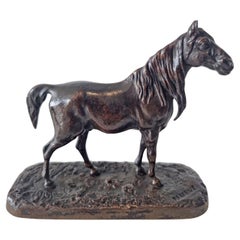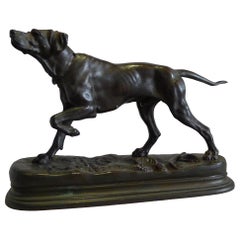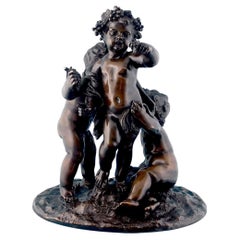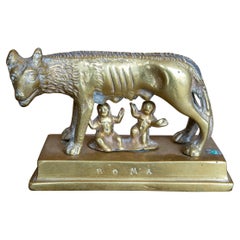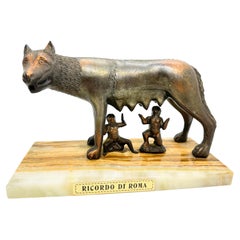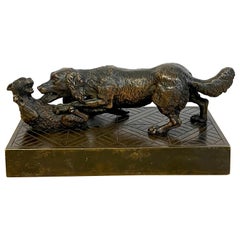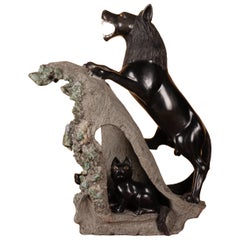Items Similar to Italian Grand Tour bronze of wolf and Romulus & Remus, the "Lupa Capitolina"
Want more images or videos?
Request additional images or videos from the seller
1 of 6
Italian Grand Tour bronze of wolf and Romulus & Remus, the "Lupa Capitolina"
$2,398.24
£1,750
€2,041.66
CA$3,284.98
A$3,653.62
CHF 1,907.81
MX$44,460.66
NOK 24,365.60
SEK 22,850.63
DKK 15,237.69
Shipping
Retrieving quote...The 1stDibs Promise:
Authenticity Guarantee,
Money-Back Guarantee,
24-Hour Cancellation
About the Item
Antique grand tour patinated bronze model of the She Wolf feeding the twins Romulus and Remus who were to become the founders of the city of Rome, the "Lupa Capitolina". The original, on the Capitoline hill is thought to be 5th century BC Etruscan, with Romulus and Remus added in the 15th century AD. A very fine quality bronze with lovely rich patination and the modelling with good definition. The two brothers below the wolf are also well modelled. Set on a beautiful piece of sienna and black marble.
- Dimensions:Height: 7.3 in (18.55 cm)Width: 5.5 in (13.97 cm)Depth: 3.4 in (8.64 cm)
- Materials and Techniques:
- Place of Origin:
- Period:
- Date of Manufacture:1860
- Condition:Wear consistent with age and use.
- Seller Location:London, GB
- Reference Number:1stDibs: LU2015340475792
About the Seller
4.7
Vetted Professional Seller
Every seller passes strict standards for authenticity and reliability
Established in 2012
1stDibs seller since 2016
90 sales on 1stDibs
Typical response time: 1 to 2 days
- ShippingRetrieving quote...Shipping from: Littlehampton, United Kingdom
- Return Policy
Authenticity Guarantee
In the unlikely event there’s an issue with an item’s authenticity, contact us within 1 year for a full refund. DetailsMoney-Back Guarantee
If your item is not as described, is damaged in transit, or does not arrive, contact us within 7 days for a full refund. Details24-Hour Cancellation
You have a 24-hour grace period in which to reconsider your purchase, with no questions asked.Vetted Professional Sellers
Our world-class sellers must adhere to strict standards for service and quality, maintaining the integrity of our listings.Price-Match Guarantee
If you find that a seller listed the same item for a lower price elsewhere, we’ll match it.Trusted Global Delivery
Our best-in-class carrier network provides specialized shipping options worldwide, including custom delivery.More From This Seller
View AllA Patinated Iron Sculpture of a Bull
Located in London, GB
A fine patinated iron model sculpture of a bull. From the collection of the late Countess Bunny Esterhazy (1938-2021)
Category
Antique 1850s French Animal Sculptures
Materials
Iron
Antique Bronze sculpture of a stallion 'Cheval Arabe' no. 1 signed P J Mene
Located in London, GB
A fine antique sculpture of a stallion, titled 'Cheval Arabe no.1' cast in bronze and signed by the most eminent of equine sculptors P. J. Mene. The bronze of small size but beautif...
Category
Antique 1860s Animal Sculptures
Materials
Bronze
Animalier Bronze of a Pointer by Jules Moingiez
By Jules Moigniez
Located in London, GB
Superb antique patinated bronze model of a pointer by Jules Moingiez. Outstanding cast and in pristine condition this shows a pointer at work in a most skillful way. The pointer aler...
Category
Antique 1880s French Animal Sculptures
Materials
Bronze
French bronze of three putti
Located in London, GB
A very fine antique French bronze of three putti playing. Although the bronze group is very much in the manner of Clodion, it is signed 'Musee de Sevres'. The bronze works well from ...
Category
Antique 1860s French Figurative Sculptures
Materials
Bronze
English Regency Bronze Stag on Ormolu & Marble Base
Located in London, GB
A lovely English Regency object, the subject that of an exhausted stag after a model made by Pitoin for Madame du Barry in 1772. The well finished stag sits on a superb ormolu base, ...
Category
Antique 1810s English Regency Animal Sculptures
Materials
Marble, Bronze, Ormolu
Grand Tour Pair of Bronze Warriors on Sienna Marble Bases
Located in London, GB
Grand tour bronzes of fighting men set on Sienna marble bases of very good colour. The two warriors in full armour and looking like medieval or renaissance soldiers are in a fighting stance both carrying shields and one carrying a mace and the other a battle axe...
Category
Antique 1880s Figurative Sculptures
Materials
Siena Marble, Bronze
You May Also Like
1970s Bronze Figure of the Capitoline She-Wolf Symbol of Rome
Located in Marbella, ES
1970s bronze figure of the Capitoline she-wolf symbol of Rome.
Category
Late 20th Century Italian Figurative Sculptures
Materials
Bronze
Rome Romulus Remus Souvenir Statue Sculpture on Marble Base Vintage Italy, 1960s
Located in Nuernberg, DE
A Rome 1960s Souvenir sculpture. Some wear with a nice patina, but this is old-age. Made of metal on a marble base. This was bought as a souvenir in Italy. A beautiful nice desktop item or just a display item...
Category
Vintage 1960s Italian Figurative Sculptures
Materials
Marble, Metal
Napoleon III Whimsical Bronze of a Playful Dog & Cat
Located in West Palm Beach, FL
Napoleon III whimsical bronze of a playful dog & cat, Nice detail, fine casting of a dog and cat engaged in play on incised brick floor, unsigned.
Category
Antique 19th Century French Napoleon III Animal Sculptures
Materials
Bronze
$920 Sale Price
20% Off
21st Century Sculpture "Wolf with the Boys"
Located in Berlin, DE
The sculpture "wolf with the boys" consists of biotite and emerald steps. The raw material was found in Scotó Bahia and handmade by the local artist Itmar. "Certificate of Authentici...
Category
21st Century and Contemporary South American Animal Sculptures
Materials
Granite
Bronze Animal Deer and Fawn Late 19th Century Signed Fratin
By Christophe Fratin
Located in Marseille, FR
Late 19th century animal bronze signed Fratin representing a wild animal having captured a young deer. Bronze mounted on wooden terrace Dimension height 29 cm for a length of 45 cm a...
Category
Antique Late 19th Century Animal Sculptures
Materials
Bronze
Early-20th Century Animaliers Bronze Entitled "Two Alsatians" by Louis Riché
Located in London, GB
A fabulous French Animalier gilt bronze group of two Alsatians, one seated in alert pose with its head turned slightly and ears pricked whilst the other one lays in an alert pose. The surface with excellent naturalistic detail and very fine colour, signed L.Riché and stamped with foundry seal for Thiebaut Frères
Additional Information
Height: 32 cm
Width: 38 cm
Condition: Excellent Original Condition
Foundry: Thiebaut Frères
Circa: 1900
Materials: Bronze
About
Louis Riché Bronze...
Category
Antique Early 1900s Animal Sculptures
Materials
Bronze
More Ways To Browse
Wolf Gold
Etruscan Sculpture
Antique Wolf
Etruscan Bronze
The Wolf Sculptures
Wolf Bronze
Wolf Bronze Sculpture
Grand Tour Sienna
Grand Tour Sienna Marble
Romulus And Remus
Capitoline Wolf
Romulus And Remus Sculpture
Small Brass Figurine
Wood Giraffe
Amber Murano Glass Sculpture
Art Deco Dog Sculpture
Elephant Statue
Prancing Horse

